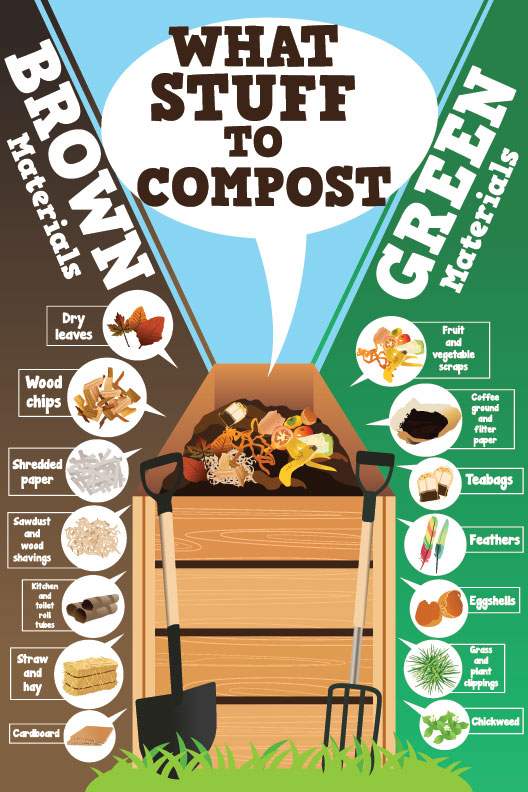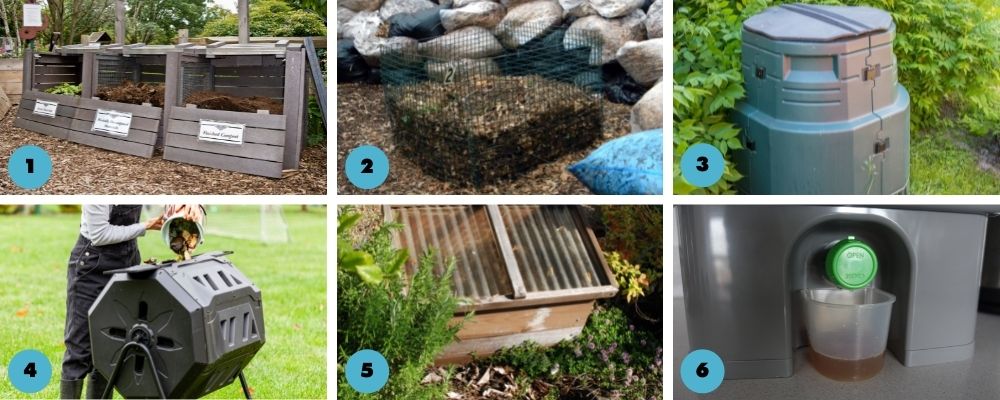The Dirt on Good Composting

Did you know that organic waste in landfill undergoes anaerobic decomposition generating methane gas? Composting is a great skill to have for your garden to increase soil fertility and microbiology whilst diverting waste from landfill. Rather than throwing out your household waste, why not start a compost today?
So how do I go about starting a compost at home? I hear you ask, well here are our Composting 101 tips to get you started!
What can I add to my compost?
There are many materials that can be used to create compost and they fall into two main categories;
Brown 'carbonaceous' material – Paper, plain cardboard, autumn leaves, plant stalks, and woody clippings.
Green 'nitrogenous' material – Fruits, vegetables, lawn clippings, weeds, and crop residue.
To achieve a good balance, add in material from both the brown and green group into your compost pile: add in about one-third green and two-thirds brown material. This does not have to be an exact science so play it by ear! Green material will add moisture to your pile so if it is looking too damp, throw in some more dry brown materials to balance and vice versa. If you don’t have enough material ready, try stockpiling up your dry materials undercover outside and freezing veggie scraps until you need them.
Did you know? - Our Jiffy pots and strips are fully biodegradable and can be added to compost or will break down when planted straight into the ground.
Prepare your compost materials by chopping them into more manageable pieces. The smaller your materials are, the quicker they will compost. Most fruit and veg scraps are fine as is and lawn clippings are perfect as they are already mulched into a fine material. Our Darlac range of pruners and shears are perfect for chopping branches, veggies and leaves into smaller pieces to help them break down quicker.
A successful compost also requires water and air. Air is important to the composting process, turning your compost regularly will incorporate air into the mix, in turn speeding up decomposition. To avoid the backbreaking task of forking over your compost heap, try using our Darlac Compost Aerator. Water may be required if adding lots of brown materials, use a watering can to lightly sprinkle water onto your heap, your pile should be moist but not soggy. If your pile gets too wet, add more dry brown matter and turn the pile to incorporate the freshly added material.
Things to avoid putting in your compost
For an aspiring composter, avoid adding any materials that could make the process difficult. Remove any flower or seed heads from weeds and keep them out of your piles as they may survive. You need a nice hot pile to kill weed seeds off (around 60-70 degrees!). Also, keep out any bulbs or thick root systems which can survive through the home compost heap. You can try drowning these materials in a bucket of water for a month or until they are completely decomposed (this is called anaerobic composting). Never add in any meat, dairy or pet waste into a home pile as these can attract pests and harbour disease.
How do I build a compost?
Your heap can be started right on top of an area of ground. Consider creating a three-sided bay with some old pallets or wood (just make sure the wood is untreated). The wooden sides will help the pile stay warm and allow you to stack it higher. Lay some straw or cardboard on the bottom of your pile as this will absorb nutrients that leach out and smother any weeds underneath. You can now start layering up your pile like you are making lasagne! Throw on a layer of green material and then more brown until you have run of out material or reached your desired height. A cubic metre is a good size to start with. If it’s too small, it will not retain heat and too large of a pile is hard to turn by hand.
Over the next few weeks, you will notice that your pile will start to reduce in size. This is decomposition taking place! It is also common to see steam rising off your pile in the mornings and is a good sign that it is warming up. Turn or aerate your pile every week if you want your pile to mature faster and create a finer product. You want to bring in the material from the outside to the inside of the pile where it will heat up and decompose. This also aerates the pile which allows the microbes to breathe.
Your compost is complete once you can no longer distinguish individual materials and it has an earthy pleasant smell. Be patient with this process as it can take a few months for a pile to mature. You can add your new compost on top of existing plantings in a fine layer or mix it into your empty garden beds for the new season!
Mr Fothergill's stocks a range of tools to help you with composting. From pruners and shears for cutting branches and a rake to help you rake up leaves, to a purpose-designed compost aerator that takes out the back-breaking effort of aerating and turning your compost pile. Check out the Darlac tool range here.

Thanks to our friends at GrowVeg for allowing us to share their composting video.

Composting FAQ's
What crops benefit from compost?
All crops benefit from having compost added to the soil to give a boost of nutrients and help retain moisture. Some plants are heavy feeders and require multiple applications of compost throughout the season to give them everything they need to grow larger, healthier, and tastier.
Some of the hungrier crops include tomatoes, cabbage, celery, eggplant, squash, pumpkins, and melons.
What shouldn’t I put into my compost?
Avoid adding materials such as meat, dairy & pet waste that can harbour diseases. Also, snip off any flowering weed seeds if your compost pile is on the cooler side as they will survive the composting process. Fats and oils should also be avoided.
Why is my compost smelling?
A smelly compost is a sign that your pile may have become anaerobic. If it looks quite soggy and smelly turn or aerate the pile to improve airflow and add in more carbon sources such as cardboard & dry leaves. A healthy compost should have a sweet smell.
Why is my compost not heating up?
It is harder to maintain a warm compost when piles are very small. Piles that are about a metre wide and tall will keep internal warmth in. Ensure you turn the pile regularly and have added in the right ratio of green and brown materials.
How long will my compost take?
The time it takes for a mature compost will vary depending on the ingredients and temperature of your pile. Some composts can take around three months to mature, others might take longer if the materials are in larger pieces and turned less regularly.
Why are there flies in my compost?
Some small critters such as vinegar flies are attracted to the food scraps in your compost bin. To keep them at bay make sure any food scraps are covered up with a generous layer of dry straw or mulch. Later when the pile is turned those ingredients will be further incorporated into the heap.
What is the best type of composter?
There are many different types of composters used by home gardeners. These can range from homemade heaps, shop-bought tumblers or indoor Bokashi units. The most popular composters are listed below along with pros and cons for each.
Composter |
Pro |
Cons |
| DIY Pallet cube |
|
|
| DIY Mesh tower |
|
|
| Plastic compost bin |
|
|
| Plastic compost tumbler |
|
|
| In ground composter |
|
|
| Indoor composter (Bokashi) |
|
|

1. Pallet Composter, 2. Mesh Tower Composter, 3. Plastic Compost Bin, 4. Plastic Tumbler Composter, 5. In Ground Composter, 6. Indoor Bokashi Composter.


